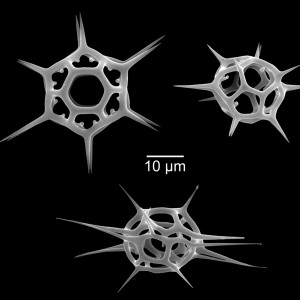University of Maine at Presque Isle Professor of Geology Kevin McCartney recently returned from a very fruitful research sabbatical in Poland. The sabbatical was to continue his longstanding research on microscopic fossil algae and resulted in the discovery of one new genus and four new species, a new understanding of silicoflagellate double skeletons, and should produce several publications in international science journals.
Dr. McCartney was in Europe from Aug. 25 to Dec. 20, on a trip that included a presentation at the 22nd International Diatom Symposium in Ghent, Belgium, visits with colleagues in Bucharest, Romania, and participation in a master’s thesis defense in Greifswald, Germany. One personal highlight of the trip was a pilgrimage to see the original fossil Archaeopteryx and the Ehrenberg collection of microscope slides in Berlin, Germany. He also viewed historic microscope slides at the science museum in Gottingen, Germany, which should result in a science paper.
McCartney also delivered a variety of talks around Poland. He spoke at the 2nd International Short Course on Siliceous Microfossils in Szczecin, Poland (his home base for his research work), in which there were 25 graduate students attending from 10 countries. He also delivered talks and conducted research and field work at the Polish Academy of Science in Warsaw and at the University of Gdansk. The most satisfying request for a talk, however, came soon after he arrived at the University of Szczecin, when a committee came to his office to ask for a talk about his “innovative teaching techniques,” a reference to the solar system models and other projects.
Most of McCartney’s time was spent at the University of Szczecin in northwestern Poland, in an area of old Prussia near the Baltic Sea. He focused on his primary research area, silicoflagellates, which are the skeletons of microscopic organisms found in sediments at the bottom of the ocean. These organisms are found in modern oceans and their fossil record extends more than 100 million years into the past, but they are poorly understood. Two skeletons sometimes occur together when the organism dies just prior to reproductive division. There has been very little study of these from either modern ocean or fossil sediments. McCartney is preparing papers on modern double skeletons for biology journals and has interpreted fossil double skeletons as well.
McCartney said that one of his most exciting discoveries while conducting research in Poland was a new understanding of silicoflagellate double skeletons from their very earliest known history. The oldest known silicoflagellates are from 115 million-year-old sediments in Antarctic waters. The skeletons are found as fragments and McCartney spent much time building models to interpret the shapes of the complete skeletons. From these models, he was also able to interpret the double skeletons: “Pretty exciting stuff,” he said. He has now worked on a wider range of silicoflagellate diversity and age than anyone else.
While in Poland, McCartney began work on several manuscripts for submission to international journals. He and several colleagues will be submitting an article on Silicoflagellate skeletal morphology and double skeletons to Phycological Research. This article will provide the first thorough study of silicoflagellates double skeletons and suggest a unified terminology for biologists and geologists. Along with two co-authors, he also is working on an article titled The Variramus group of early silicoflagellates: Evolution, Taxonomy and Double Skeletons to Cretaceous Research. This article will use innovative techniques (physical models) to interpret double skeleton configurations for the oldest known silicoflagellates, and will describe McCartney’s newly identified genus and species.
McCartney has at least three other manuscripts in the works—on Late Cretaceous silicoflagellates from the eastern Urals of Russia, Late Cretaceous silicoflagellates flora from the Saratov region of Central Russia, and silicoflagellates and diatoms recovered from fossil sponges on the Baltic coast. He will be first author for most of these papers, but altogether there are more than a dozen co-authors from at least seven countries. McCartney is a leading authority in his field and is working to bring biologists and geologists together to resolve some major problems in silicoflagellate study.
During his travels, McCartney also was fully involved in his host department and community, assisting colleagues and students in developing—and in the English editing of—a variety of papers, grant proposals and community activities. These included papers on bioindicators in marine waters, descriptions of several diatom species, and an analysis of variation in siliceous microfossil assemblages. He also regularly attended a local Szczecin Rotary Club and contributed ideas and work on their major fundraising program.
He also kept a blog during his trip, sharing with readers his experiences with Polish culture, from the kawa (coffee) to using the escalators (inclined, not stepped) to Polish TV—”the person you see on the advertisements-selling just about anything… is Chuck Norris.” To revisit these moments and read rich detail about his research and travels, check out http://wp.umpi.edu/kevinmccartney/.
One special surprise for Dr. McCartney was learning that a species of freshwater diatom from Lake Baikal, Russia is being named after him. And there’s still more to come. While on sabbatical, he received an invitation to participate in an August 2013 paleobiogeography symposium in Russia and he also was asked by his host department at Szczecin to submit a Fulbright Fellowship proposal to enable future work in Poland.
“A sabbatical is never a time to finish old projects but a time to start new ones, and develop the connections and resources to keep busy for years to come,” he said.
It seems that his sabbatical did all that and more.

